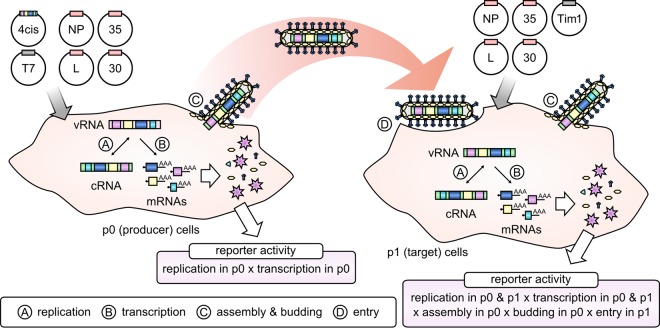FIG 1.
Schematic representation of a trVLP assay using a tetracistronic minigenome. 293 cells (called producer, or p0, cells) are transfected with expression plasmids for the RNP proteins NP, VP35, VP30, and L, as well as a tetracistronic minigenome (4cis) and the accessory T7 RNA polymerase (T7). After initial, T7-driven transcription, the vRNA minigenome is replicated through a cRNA intermediate by the viral proteins NP, VP35, and L and transcribed by these proteins and VP30 into mRNAs encoding a luciferase reporter as well as the viral proteins VP40, VP24, and GP1,2. This leads to reporter activity (reflecting genome replication and transcription in p0 cells) as well as the formation of trVLPs that harbor a minigenome-containing nucleocapsid and are coated with GP1,2. These trVLPs can infect and enter target cells, where their minigenome is replicated and transcribed by NP, VP35, VP30, and L provided in trans from expression plasmids. This leads to reporter activity in these target cells (reflecting genome replication and transcription in p0 and p1 cells, assembly and budding of trVLP from p0 cells, and their entry into p1 cells) as well as to the generation of new trVLPs that can infect new target cells, leading to ongoing infection over multiple infectious cycles, as long as NP, VP35, VP30, and L are supplied in target cells.

